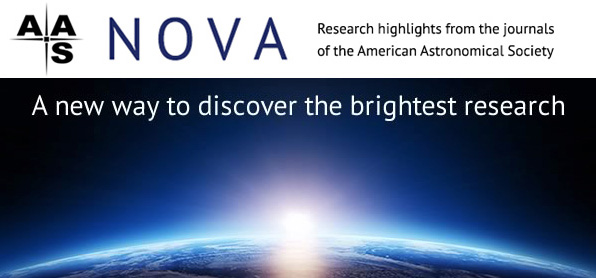Highlights from AAS Nova: 7 - 20 August 2016

Susanna Kohler American Astronomical Society (AAS)
AAS Nova provides brief highlights of recently published articles from the AAS journals, i.e., The Astronomical Journal (AJ) and The Astrophysical Journal (ApJ), ApJ Letters, and ApJ Supplements. The website's intent is to gain broader exposure for AAS authors and to provide astronomy researchers and enthusiasts with summaries of recent, interesting research across a wide range of astronomical fields.
The following are the AAS Nova highlights from the past two weeks; follow the links to read more, or visit the AAS Nova webpage for more posts.
19 August 2016
A High-Velocity Collision With Our Galaxy’s Disk
A new study finds evidence that a high-velocity cloud may have smashed into the Milky Way’s disk five million years ago.
17 August 2016
History of a Rare Radio Galaxy Revealed by Its Jets
The unusual structure of a recently discovered radio galaxy gives scientists clues about its temperamental past.
16 August 2016
Why Is Mercury So Far from the Sun?
Why is Mercury’s orbit so large, compared to the close-in orbits of the planets observed in many exoplanetary systems? Astrobites reports on a recent study seeking to answer this question.
15 August 2016
Models of a Circumbinary Disk
This image captures a scene from a simulation of a binary star system surrounded by a circumbinary disk.
12 August 2016
A New Player in the Search for Extraterrestrial Intelligence
Can we find life beyond Earth? A new experiment in the Search for ExtraTerrestrial Intelligence (SETI) has been conducted at the Murchison Widefield Array in Australia.
10 August 2016
Exploring the Birth of Binary Stars
More than half of all stars are thought to be in binary or multiple star systems. But how do these systems form? The misaligned spins of some binary protostars might provide a clue.
9 August 2016
Investigating Local Galaxies to Learn About Distant Ones
Astrobites reports on a study of nearby galaxies that mimic the properties of those found in the distant universe.
8 August 2016
K2’s First Five-Planet System
Kepler’s K2 mission has found its first planetary system containing more than three planets — an exciting five-planet system located ~380 light-years from Earth.


